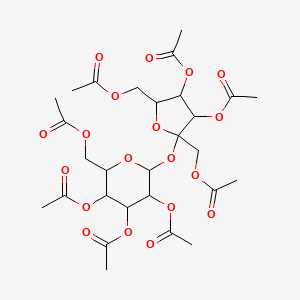
Sulfasalazina
Descripción general
Descripción
La sulfasalazina es un medicamento que se utiliza principalmente para tratar enfermedades inflamatorias intestinales como la colitis ulcerosa y la enfermedad de Crohn, así como la artritis reumatoide . Es un miembro de la clase de fármacos sulfonamida y es conocido por sus propiedades antiinflamatorias e inmunomoduladoras . La this compound se introdujo por primera vez en la década de 1940 y desde entonces se ha convertido en un elemento básico en el tratamiento de diversas afecciones inflamatorias .
Mecanismo De Acción
La sulfasalazina ejerce sus efectos a través de múltiples mecanismos:
Acción antiinflamatoria: Inhibe la producción de citocinas proinflamatorias y prostaglandinas, reduciendo la inflamación en el colon.
Efectos inmunomoduladores: Modula la respuesta inmune al afectar la función de las células T y la producción de citocinas.
Actividad antibacteriana: El componente sulfapiridina tiene propiedades antibacterianas que ayudan a controlar la flora intestinal.
Aplicaciones Científicas De Investigación
La sulfasalazina tiene una amplia gama de aplicaciones en la investigación científica:
Análisis Bioquímico
Biochemical Properties
Sulfasalazine and its metabolites, 5-aminosalicylic acid and sulfapyridine, are involved in various biochemical reactions .
Cellular Effects
Sulfasalazine has been found to have significant effects on various types of cells and cellular processes. It helps to reduce pain and swelling and lowers inflammation in the body . It limits the damage that rheumatoid arthritis causes to joints, helping to prevent disease progression .
Molecular Mechanism
One proposed mechanism is the inhibition of prostaglandins, resulting in local anti-inflammatory effects in the colon . It is also thought that Sulfasalazine and its metabolites can inhibit leukotrienes and prostaglandins by blocking the cyclo-oxygenase .
Temporal Effects in Laboratory Settings
In laboratory settings, Sulfasalazine-induced cytopenia, nephrotoxicity, and hepatotoxicity are uncommon during long-term treatment . Some guidelines recommend 3 monthly monitoring blood tests indefinitely during long-term treatment while others recommend stopping monitoring after 1 year .
Dosage Effects in Animal Models
The effects of Sulfasalazine vary with different dosages in animal models . The effects of Sulfasalazine and the analogues olsalazine, 5-aminosalicylic acid, and 4-aminosalicylic acid, in different experimental animal models have been reviewed .
Metabolic Pathways
Sulfasalazine is involved in various metabolic pathways. It is broken down by intestinal bacteria into sulfapyridine and 5-aminosalicylic acid . Sulfasalazine could improve therapy by sensitizing to cisplatin through killing CD44v9-positive cells and modifying the metabolic pathways, in particular tryptophan degradation (i.e., kynurenine pathway, serotonin pathway) and nucleic acid metabolism .
Transport and Distribution
Sulfasalazine is generally administered as enteric-coated tablets which release the drug in the small intestine . Some Sulfasalazine is absorbed in the small intestine but is limited due to transport back to the intestine by breast cancer resistance protein (ATP-binding cassette subfamily G member 2) .
Subcellular Localization
The subcellular localization of Sulfasalazine and its effects on its activity or function are not well studied. It is known that Sulfasalazine is too big to be absorbed by the small intestine, but bacteria in the colon can break the bond between 5-ASA and sulfapyridine, which frees 5-ASA to work locally in the colon to help in ulcerative colitis .
Métodos De Preparación
Rutas sintéticas y condiciones de reacción
La sulfasalazina se sintetiza a través de una serie de reacciones químicas que comienzan con sulfapiridina y ácido salicílico. El proceso implica una reacción de diazotación seguida de una reacción de acoplamiento . Aquí hay un esquema simplificado de la síntesis:
Reacción de diazotación: La sulfapiridina se disuelve en una solución acuosa que contiene ácido clorhídrico y nitrito de sodio para formar una sal de diazonio.
Reacción de acoplamiento: La sal de diazonio se hace reaccionar entonces con ácido salicílico en una solución de hidróxido de sodio para producir this compound.
Métodos de producción industrial
En entornos industriales, la síntesis de this compound sigue pasos similares, pero a mayor escala. Las reacciones se controlan cuidadosamente para garantizar un alto rendimiento y pureza. El producto final suele formularse en tabletas o preparados con recubrimiento entérico para mejorar la biodisponibilidad y reducir los efectos secundarios gastrointestinales .
Análisis De Reacciones Químicas
Tipos de reacciones
La sulfasalazina experimenta varios tipos de reacciones químicas, incluyendo:
Oxidación y reducción: La this compound puede sufrir reacciones de oxidación y reducción, particularmente en el hígado, donde se metaboliza.
Reacciones de sustitución: El compuesto puede participar en reacciones de sustitución, especialmente en presencia de nucleófilos o electrófilos fuertes.
Reactivos y condiciones comunes
Hidrólisis: Catalizada por enzimas bacterianas en el colon.
Oxidación: A menudo implica enzimas citocromo P450 en el hígado.
Reducción: Puede ocurrir en condiciones anaeróbicas en el intestino.
Principales productos formados
Sulfapiridina: Un metabolito activo con propiedades antibacterianas.
Ácido 5-aminosalicílico: Un agente antiinflamatorio que actúa localmente en el colon.
Comparación Con Compuestos Similares
Compuestos similares
Mesalazina (ácido 5-aminosalicílico): Comparte las propiedades antiinflamatorias pero carece del componente sulfonamida.
Derivados de la sulfasalazina: Versiones modificadas de la this compound con propiedades farmacocinéticas alteradas.
Singularidad
La this compound es única debido a su doble acción como agente antiinflamatorio y antibacteriano. Su capacidad para ser metabolizada en dos componentes activos, sulfapiridina y ácido 5-aminosalicílico, proporciona un enfoque multifacético para el tratamiento de enfermedades inflamatorias .
Propiedades
IUPAC Name |
2-hydroxy-5-[[4-(pyridin-2-ylsulfamoyl)phenyl]diazenyl]benzoic acid | |
|---|---|---|
| Source | PubChem | |
| URL | https://pubchem.ncbi.nlm.nih.gov | |
| Description | Data deposited in or computed by PubChem | |
InChI |
InChI=1S/C18H14N4O5S/c23-16-9-6-13(11-15(16)18(24)25)21-20-12-4-7-14(8-5-12)28(26,27)22-17-3-1-2-10-19-17/h1-11,23H,(H,19,22)(H,24,25) | |
| Source | PubChem | |
| URL | https://pubchem.ncbi.nlm.nih.gov | |
| Description | Data deposited in or computed by PubChem | |
InChI Key |
NCEXYHBECQHGNR-UHFFFAOYSA-N | |
| Source | PubChem | |
| URL | https://pubchem.ncbi.nlm.nih.gov | |
| Description | Data deposited in or computed by PubChem | |
Canonical SMILES |
C1=CC=NC(=C1)NS(=O)(=O)C2=CC=C(C=C2)N=NC3=CC(=C(C=C3)O)C(=O)O | |
| Source | PubChem | |
| URL | https://pubchem.ncbi.nlm.nih.gov | |
| Description | Data deposited in or computed by PubChem | |
Molecular Formula |
C18H14N4O5S | |
| Record name | SALICYLAZOSULFAPYRIDINE | |
| Source | CAMEO Chemicals | |
| URL | https://cameochemicals.noaa.gov/chemical/20999 | |
| Description | CAMEO Chemicals is a chemical database designed for people who are involved in hazardous material incident response and planning. CAMEO Chemicals contains a library with thousands of datasheets containing response-related information and recommendations for hazardous materials that are commonly transported, used, or stored in the United States. CAMEO Chemicals was developed by the National Oceanic and Atmospheric Administration's Office of Response and Restoration in partnership with the Environmental Protection Agency's Office of Emergency Management. | |
| Explanation | CAMEO Chemicals and all other CAMEO products are available at no charge to those organizations and individuals (recipients) responsible for the safe handling of chemicals. However, some of the chemical data itself is subject to the copyright restrictions of the companies or organizations that provided the data. | |
| Source | PubChem | |
| URL | https://pubchem.ncbi.nlm.nih.gov | |
| Description | Data deposited in or computed by PubChem | |
DSSTOX Substance ID |
DTXSID0021256 | |
| Record name | Sulfasalazine | |
| Source | EPA DSSTox | |
| URL | https://comptox.epa.gov/dashboard/DTXSID0021256 | |
| Description | DSSTox provides a high quality public chemistry resource for supporting improved predictive toxicology. | |
Molecular Weight |
398.4 g/mol | |
| Source | PubChem | |
| URL | https://pubchem.ncbi.nlm.nih.gov | |
| Description | Data deposited in or computed by PubChem | |
Physical Description |
Salicylazosulfapyridine appears as odorless yellow or brownish-yellow to orange powder. Tasteless. (NTP, 1992) It is a sulfa drug used as an antibiotic. | |
| Record name | SALICYLAZOSULFAPYRIDINE | |
| Source | CAMEO Chemicals | |
| URL | https://cameochemicals.noaa.gov/chemical/20999 | |
| Description | CAMEO Chemicals is a chemical database designed for people who are involved in hazardous material incident response and planning. CAMEO Chemicals contains a library with thousands of datasheets containing response-related information and recommendations for hazardous materials that are commonly transported, used, or stored in the United States. CAMEO Chemicals was developed by the National Oceanic and Atmospheric Administration's Office of Response and Restoration in partnership with the Environmental Protection Agency's Office of Emergency Management. | |
| Explanation | CAMEO Chemicals and all other CAMEO products are available at no charge to those organizations and individuals (recipients) responsible for the safe handling of chemicals. However, some of the chemical data itself is subject to the copyright restrictions of the companies or organizations that provided the data. | |
Solubility |
less than 1 mg/mL at 77 °F (NTP, 1992), Practically insoluble in water, Very slightly soluble in ethanol; practically insoluble in diethyl ether, chloroform, and benzene; soluble in aqueous solution of alkali hydroxides | |
| Record name | SALICYLAZOSULFAPYRIDINE | |
| Source | CAMEO Chemicals | |
| URL | https://cameochemicals.noaa.gov/chemical/20999 | |
| Description | CAMEO Chemicals is a chemical database designed for people who are involved in hazardous material incident response and planning. CAMEO Chemicals contains a library with thousands of datasheets containing response-related information and recommendations for hazardous materials that are commonly transported, used, or stored in the United States. CAMEO Chemicals was developed by the National Oceanic and Atmospheric Administration's Office of Response and Restoration in partnership with the Environmental Protection Agency's Office of Emergency Management. | |
| Explanation | CAMEO Chemicals and all other CAMEO products are available at no charge to those organizations and individuals (recipients) responsible for the safe handling of chemicals. However, some of the chemical data itself is subject to the copyright restrictions of the companies or organizations that provided the data. | |
| Record name | Sulfasalazine | |
| Source | Hazardous Substances Data Bank (HSDB) | |
| URL | https://pubchem.ncbi.nlm.nih.gov/source/hsdb/3395 | |
| Description | The Hazardous Substances Data Bank (HSDB) is a toxicology database that focuses on the toxicology of potentially hazardous chemicals. It provides information on human exposure, industrial hygiene, emergency handling procedures, environmental fate, regulatory requirements, nanomaterials, and related areas. The information in HSDB has been assessed by a Scientific Review Panel. | |
Mechanism of Action |
Although the exact mechanism of action of sulfasalazine is not fully understood, it is thought to be mediated through the inhibition of various inflammatory molecules. Research have found that sulfasalazine and its metabolites, mesalazine and sulfapyridine, can inhibit leukotrienes and prostaglandins by blocking the cyclo-oxygenase and lipoxygenase pathway. Specific enzymes that were investigated include phospholipase A2, cyclooxygenase-1 (COX-1), cyclooxygenase-2 (COX2), and arachidonate 5-lipoxygenase., Sulfonamide combined with an anti-inflammatory drug. Sulfasalazine has little effect and salicylic acid (mesalamine) has anti-inflammatory effects. ... When administered as the combination of salicylic acid and the sulfonamide, sulfapyridine, the salicylic acid is released by colonic bacteria to produce an anti-inflammatory effect. The anti-inflammatory effect is believed to be through antiprostaglandin action, antileukotriene activity, or both., ... The purpose of the present study was to determine whether sulfasalazine therapy affected NF-kappaB activation and the expression of pro-inflammatory cytokines in patients with ulcerative colitis. ... A total of 38 patients with moderate ulcerative colitis were investigated. Twenty-one patients received sulfasalazine. Seventeen patients did not receive any medication. Biopsy specimens were obtained from inflamed mucosa and analyzed for NF-kappaB DNA binding activity, NF-kappaBp65/IkappaBalpha protein expression and the levels of pro-inflammatory cytokine mRNA using electrophoretic mobility shift assay, western blot analysis, immunohistochemical staining and reverse transcription-polymerase chain reaction (RT-PCR) analysis, respectively. Increased activation of NF-kappaB and high levels of the expression of interleukin (IL)-1beta mRNA and IL-8 mRNA were detected in biopsy specimens from patients with ulcerative colitis. Therapeutic administration of sulfasalazine effectively downregulated the activation of NF-kappaB and the expression of IL-1beta mRNA and IL-8 mRNA while IkappaBalpha levels were stable. /The authors concluded that/ the therapeutic benefits for ulcerative colitis of sulfasalazine might at least in part be attributed to its ability to inhibit NF-kappaB activation, resulting in the downregulation of pro-inflammatory cytokine mRNA expression. | |
| Record name | Sulfasalazine | |
| Source | DrugBank | |
| URL | https://www.drugbank.ca/drugs/DB00795 | |
| Description | The DrugBank database is a unique bioinformatics and cheminformatics resource that combines detailed drug (i.e. chemical, pharmacological and pharmaceutical) data with comprehensive drug target (i.e. sequence, structure, and pathway) information. | |
| Explanation | Creative Common's Attribution-NonCommercial 4.0 International License (http://creativecommons.org/licenses/by-nc/4.0/legalcode) | |
| Record name | Sulfasalazine | |
| Source | Hazardous Substances Data Bank (HSDB) | |
| URL | https://pubchem.ncbi.nlm.nih.gov/source/hsdb/3395 | |
| Description | The Hazardous Substances Data Bank (HSDB) is a toxicology database that focuses on the toxicology of potentially hazardous chemicals. It provides information on human exposure, industrial hygiene, emergency handling procedures, environmental fate, regulatory requirements, nanomaterials, and related areas. The information in HSDB has been assessed by a Scientific Review Panel. | |
Color/Form |
Minute, brownish-yellow crystals, Light brownish yellow to bright yellow fine powder | |
CAS No. |
599-79-1 | |
| Record name | SALICYLAZOSULFAPYRIDINE | |
| Source | CAMEO Chemicals | |
| URL | https://cameochemicals.noaa.gov/chemical/20999 | |
| Description | CAMEO Chemicals is a chemical database designed for people who are involved in hazardous material incident response and planning. CAMEO Chemicals contains a library with thousands of datasheets containing response-related information and recommendations for hazardous materials that are commonly transported, used, or stored in the United States. CAMEO Chemicals was developed by the National Oceanic and Atmospheric Administration's Office of Response and Restoration in partnership with the Environmental Protection Agency's Office of Emergency Management. | |
| Explanation | CAMEO Chemicals and all other CAMEO products are available at no charge to those organizations and individuals (recipients) responsible for the safe handling of chemicals. However, some of the chemical data itself is subject to the copyright restrictions of the companies or organizations that provided the data. | |
| Record name | Sulfasalazine | |
| Source | CAS Common Chemistry | |
| URL | https://commonchemistry.cas.org/detail?cas_rn=599-79-1 | |
| Description | CAS Common Chemistry is an open community resource for accessing chemical information. Nearly 500,000 chemical substances from CAS REGISTRY cover areas of community interest, including common and frequently regulated chemicals, and those relevant to high school and undergraduate chemistry classes. This chemical information, curated by our expert scientists, is provided in alignment with our mission as a division of the American Chemical Society. | |
| Explanation | The data from CAS Common Chemistry is provided under a CC-BY-NC 4.0 license, unless otherwise stated. | |
| Record name | Sulfasalazine [USAN:USP:INN:BAN] | |
| Source | ChemIDplus | |
| URL | https://pubchem.ncbi.nlm.nih.gov/substance/?source=chemidplus&sourceid=0000599791 | |
| Description | ChemIDplus is a free, web search system that provides access to the structure and nomenclature authority files used for the identification of chemical substances cited in National Library of Medicine (NLM) databases, including the TOXNET system. | |
| Record name | Sulfasalazine | |
| Source | DrugBank | |
| URL | https://www.drugbank.ca/drugs/DB00795 | |
| Description | The DrugBank database is a unique bioinformatics and cheminformatics resource that combines detailed drug (i.e. chemical, pharmacological and pharmaceutical) data with comprehensive drug target (i.e. sequence, structure, and pathway) information. | |
| Explanation | Creative Common's Attribution-NonCommercial 4.0 International License (http://creativecommons.org/licenses/by-nc/4.0/legalcode) | |
| Record name | sulfasalazine | |
| Source | DTP/NCI | |
| URL | https://dtp.cancer.gov/dtpstandard/servlet/dwindex?searchtype=NSC&outputformat=html&searchlist=757330 | |
| Description | The NCI Development Therapeutics Program (DTP) provides services and resources to the academic and private-sector research communities worldwide to facilitate the discovery and development of new cancer therapeutic agents. | |
| Explanation | Unless otherwise indicated, all text within NCI products is free of copyright and may be reused without our permission. Credit the National Cancer Institute as the source. | |
| Record name | sulfasalazine | |
| Source | DTP/NCI | |
| URL | https://dtp.cancer.gov/dtpstandard/servlet/dwindex?searchtype=NSC&outputformat=html&searchlist=667219 | |
| Description | The NCI Development Therapeutics Program (DTP) provides services and resources to the academic and private-sector research communities worldwide to facilitate the discovery and development of new cancer therapeutic agents. | |
| Explanation | Unless otherwise indicated, all text within NCI products is free of copyright and may be reused without our permission. Credit the National Cancer Institute as the source. | |
| Record name | sulfasalazine | |
| Source | DTP/NCI | |
| URL | https://dtp.cancer.gov/dtpstandard/servlet/dwindex?searchtype=NSC&outputformat=html&searchlist=203730 | |
| Description | The NCI Development Therapeutics Program (DTP) provides services and resources to the academic and private-sector research communities worldwide to facilitate the discovery and development of new cancer therapeutic agents. | |
| Explanation | Unless otherwise indicated, all text within NCI products is free of copyright and may be reused without our permission. Credit the National Cancer Institute as the source. | |
| Record name | Sulfasalazine | |
| Source | EPA DSSTox | |
| URL | https://comptox.epa.gov/dashboard/DTXSID0021256 | |
| Description | DSSTox provides a high quality public chemistry resource for supporting improved predictive toxicology. | |
| Record name | Salazosulfapyridine | |
| Source | European Chemicals Agency (ECHA) | |
| URL | https://echa.europa.eu/substance-information/-/substanceinfo/100.009.069 | |
| Description | The European Chemicals Agency (ECHA) is an agency of the European Union which is the driving force among regulatory authorities in implementing the EU's groundbreaking chemicals legislation for the benefit of human health and the environment as well as for innovation and competitiveness. | |
| Explanation | Use of the information, documents and data from the ECHA website is subject to the terms and conditions of this Legal Notice, and subject to other binding limitations provided for under applicable law, the information, documents and data made available on the ECHA website may be reproduced, distributed and/or used, totally or in part, for non-commercial purposes provided that ECHA is acknowledged as the source: "Source: European Chemicals Agency, http://echa.europa.eu/". Such acknowledgement must be included in each copy of the material. ECHA permits and encourages organisations and individuals to create links to the ECHA website under the following cumulative conditions: Links can only be made to webpages that provide a link to the Legal Notice page. | |
| Record name | SULFASALAZINE | |
| Source | FDA Global Substance Registration System (GSRS) | |
| URL | https://gsrs.ncats.nih.gov/ginas/app/beta/substances/3XC8GUZ6CB | |
| Description | The FDA Global Substance Registration System (GSRS) enables the efficient and accurate exchange of information on what substances are in regulated products. Instead of relying on names, which vary across regulatory domains, countries, and regions, the GSRS knowledge base makes it possible for substances to be defined by standardized, scientific descriptions. | |
| Explanation | Unless otherwise noted, the contents of the FDA website (www.fda.gov), both text and graphics, are not copyrighted. They are in the public domain and may be republished, reprinted and otherwise used freely by anyone without the need to obtain permission from FDA. Credit to the U.S. Food and Drug Administration as the source is appreciated but not required. | |
| Record name | Sulfasalazine | |
| Source | Hazardous Substances Data Bank (HSDB) | |
| URL | https://pubchem.ncbi.nlm.nih.gov/source/hsdb/3395 | |
| Description | The Hazardous Substances Data Bank (HSDB) is a toxicology database that focuses on the toxicology of potentially hazardous chemicals. It provides information on human exposure, industrial hygiene, emergency handling procedures, environmental fate, regulatory requirements, nanomaterials, and related areas. The information in HSDB has been assessed by a Scientific Review Panel. | |
Melting Point |
464 to 473 °F (decomposes) (NTP, 1992), 220 °C (decomposes) | |
| Record name | SALICYLAZOSULFAPYRIDINE | |
| Source | CAMEO Chemicals | |
| URL | https://cameochemicals.noaa.gov/chemical/20999 | |
| Description | CAMEO Chemicals is a chemical database designed for people who are involved in hazardous material incident response and planning. CAMEO Chemicals contains a library with thousands of datasheets containing response-related information and recommendations for hazardous materials that are commonly transported, used, or stored in the United States. CAMEO Chemicals was developed by the National Oceanic and Atmospheric Administration's Office of Response and Restoration in partnership with the Environmental Protection Agency's Office of Emergency Management. | |
| Explanation | CAMEO Chemicals and all other CAMEO products are available at no charge to those organizations and individuals (recipients) responsible for the safe handling of chemicals. However, some of the chemical data itself is subject to the copyright restrictions of the companies or organizations that provided the data. | |
| Record name | Sulfasalazine | |
| Source | DrugBank | |
| URL | https://www.drugbank.ca/drugs/DB00795 | |
| Description | The DrugBank database is a unique bioinformatics and cheminformatics resource that combines detailed drug (i.e. chemical, pharmacological and pharmaceutical) data with comprehensive drug target (i.e. sequence, structure, and pathway) information. | |
| Explanation | Creative Common's Attribution-NonCommercial 4.0 International License (http://creativecommons.org/licenses/by-nc/4.0/legalcode) | |
| Record name | Sulfasalazine | |
| Source | Hazardous Substances Data Bank (HSDB) | |
| URL | https://pubchem.ncbi.nlm.nih.gov/source/hsdb/3395 | |
| Description | The Hazardous Substances Data Bank (HSDB) is a toxicology database that focuses on the toxicology of potentially hazardous chemicals. It provides information on human exposure, industrial hygiene, emergency handling procedures, environmental fate, regulatory requirements, nanomaterials, and related areas. The information in HSDB has been assessed by a Scientific Review Panel. | |
Retrosynthesis Analysis
AI-Powered Synthesis Planning: Our tool employs the Template_relevance Pistachio, Template_relevance Bkms_metabolic, Template_relevance Pistachio_ringbreaker, Template_relevance Reaxys, Template_relevance Reaxys_biocatalysis model, leveraging a vast database of chemical reactions to predict feasible synthetic routes.
One-Step Synthesis Focus: Specifically designed for one-step synthesis, it provides concise and direct routes for your target compounds, streamlining the synthesis process.
Accurate Predictions: Utilizing the extensive PISTACHIO, BKMS_METABOLIC, PISTACHIO_RINGBREAKER, REAXYS, REAXYS_BIOCATALYSIS database, our tool offers high-accuracy predictions, reflecting the latest in chemical research and data.
Strategy Settings
| Precursor scoring | Relevance Heuristic |
|---|---|
| Min. plausibility | 0.01 |
| Model | Template_relevance |
| Template Set | Pistachio/Bkms_metabolic/Pistachio_ringbreaker/Reaxys/Reaxys_biocatalysis |
| Top-N result to add to graph | 6 |
Feasible Synthetic Routes
Descargo de responsabilidad e información sobre productos de investigación in vitro
Tenga en cuenta que todos los artículos e información de productos presentados en BenchChem están destinados únicamente con fines informativos. Los productos disponibles para la compra en BenchChem están diseñados específicamente para estudios in vitro, que se realizan fuera de organismos vivos. Los estudios in vitro, derivados del término latino "in vidrio", involucran experimentos realizados en entornos de laboratorio controlados utilizando células o tejidos. Es importante tener en cuenta que estos productos no se clasifican como medicamentos y no han recibido la aprobación de la FDA para la prevención, tratamiento o cura de ninguna condición médica, dolencia o enfermedad. Debemos enfatizar que cualquier forma de introducción corporal de estos productos en humanos o animales está estrictamente prohibida por ley. Es esencial adherirse a estas pautas para garantizar el cumplimiento de los estándares legales y éticos en la investigación y experimentación.



![3-amino-N-(5-phenyl-1,3,4-thiadiazol-2-yl)-6,7,8,9-tetrahydro-5H-cyclohepta[b]thieno[3,2-e]pyridine-2-carboxamide](/img/structure/B1682631.png)












